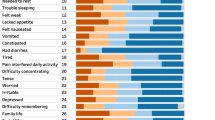Abstract
Purpose
Health related quality of life (HRQOL) is an important outcome in cancer care and needs assessment by a valid questionnaire. HRQOL questionnaires need to be validated after translations to other languages and cultural settings. The purpose of this study is to evaluate the psychometric properties of the Arabic version of the European Organization for Research and Treatment of Cancer Quality of Life 15 items Questionnaire for Palliative Care (EORTC QLQ-C15-PAL).
Methods
This is a cross-sectional study of a convenient sample of inpatients with cancer.
Results
One hundred seventy-five patients completed the EORTC QLQ-C15-PAL questionnaire. Cronbach’s alpha coefficient met the 0.7 alpha criterion. Confirmatory factor analysis met the goodness of fit criteria; goodness-of-fit index (GFI), comparative fit index (CFI), normed fit index (NFI) and non-normed fit index (NNFI) >0.90 and root mean square error of approximation (RMSEA) <0.06. All item-scale correlation coefficients exceeded the set value of 0.40, indicating satisfactory convergent validity. In terms of discriminant validity, all items in the questionnaire showed a higher item-scale correlation than item-other scale correlation, except for items 1 and 2 (physical function scale) that showed a higher correlation with fatigue. Construct validity was tested by item inter scale correlation coefficient. All constructs had correlation coefficient <0.70. External validity was tested by comparison of scores of patients who had metastasis and who did not have metastasis. Significant differences (P value <0.05) were found in all scales except for nausea. Age groups were compared and showed significant differences for physical function, fatigue, and global score of HRQOL.
Conclusion
The Arabic version of the EORTC QLQ-C15-PAL is valid and reliable.

Similar content being viewed by others
References
Bottomley A (2002) The cancer patient and quality of life. Oncologist 7(2):120–125
Arraras JI, Duenas T, Meirino R, Pruja E, Villafranca E, Valerdi JJ (1998) Quality of life of cancer patients: studies by the Oncology Department of the Hospital of Navarra in the Quality of Life Group of the EORTC. Anales del sistema sanitario de Navarra 21(1):47–53
Bottomley A, Vanvoorden V, Flechtner H, Therasse P (2003) The challenges and achievements involved in implementing Quality of Life research in cancer clinical trials. Eur J Cancer 39(3):275–285
Groenvold M, Petersen MA, Aaronson NK, Arraras JI, Blazeby JM, Bottomley A, Fayers PM, de Graeff A, Hammerlid E, Kaasa S, Sprangers MA, Bjorner JB (2006) The development of the EORTC QLQ-C15-PAL: a shortened questionnaire for cancer patients in palliative care. Eur J Cancer 42(1):55–64. doi:10.1016/j.ejca.2005.06.022
Arraras JI, de la Vega FA, Asin G, Rico M, Zarandona U, Eito C, Cambra K, Barrondo M, Errasti M, Verdun J, Rivadeneira J, Dominguez MA (2014) The EORTC QLQ-C15-PAL questionnaire: validation study for Spanish bone metastases patients. Qual Life Res 23(3):849–855. doi:10.1007/s11136-013-0511-9
Miyashita M, Wada M, Morita T, Ishida M, Onishi H, Sasaki Y, Narabayashi M, Wada T, Matsubara M, Takigawa C, Shinjo T, Suga A, Inoue S, Ikenaga M, Kohara H, Tsuneto S, Shima Y (2015) Independent validation of the Japanese version of the EORTC QLQ-C15-PAL for patients with advanced cancer. J Pain Symptom Manag. doi:10.1016/j.jpainsymman.2014.11.299
Miyazaki K, Suzukamo Y, Shimozuma K, Nakayama T (2012) Verification of the psychometric properties of the Japanese version of the European Organization for Research and Treatment of Cancer Quality of Life Questionnaire Core 15 palliative (EORTCQLQ-C15-PAL). Qual Life Res 21(2):335–340. doi:10.1007/s11136-011-9939-y
Nunes NAH (2014) The quality of life of Brazilian patients in palliative care: validation of the European Organization for Research and Treatment of Cancer Quality of Life Questionnaire Core 15 PAL (EORTC QLQ-C15-PAL). Support Care Cancer 22(6):1595–1600. doi:10.1007/s00520-014-2119-1
Shin DW, Choi JE, Miyashita M, Choi JY, Kang J, Baik YJ, Mo HN, Park J, Kim HJ, Park EC (2011) Cross-cultural application of the Korean version of the European Organization for Research and Treatment of Cancer Quality of Life Questionnaire-Core 15-Palliative Care. J Pain Symptom Manag 41(2):478–484. doi:10.1016/j.jpainsymman.2010.05.009
Suarez-del-Real Y, Allende-Perez S, Alferez-Mancera A, Rodriguez RB, Jimenez-Toxtle S, Mohar A, Onate-Ocana LF (2011) Validation of the Mexican-Spanish version of the EORTC QLQ-C15-PAL questionnaire for the evaluation of health-related quality of life in patients on palliative care. Psycho-Oncology 20(8):889–896. doi:10.1002/pon.1801
Fatiha Sadat FK, Atefeh Farzindar Automatic Identification of Arabic Language Varieties and Dialects in Social Media. Proceedings of the Second Workshop on Natural Language Processing for Social Media (SocialNLP), pages 22–27, Dublin, Ireland, August 24 2014
Huijer HA, Sagherian K, Tamim H (2013) Validation of the Arabic version of the EORTC quality of life questionnaire among cancer patients in Lebanon. Qual Life Res 22(6):1473–1481. doi:10.1007/s11136-012-0261-0
Linda Dewolf MK, Galina Velikova, Colin Johnson, Neil Scott, Andrew Bottomley on behalf of the EORTC Quality of Life Group (2009)
Jones SN (1995) Interventional radiology in a palliative care setting. Palliat Med 9(4):319–326
Hjermstad MJ, Fayers PM, Bjordal K, Kaasa S (1998) Health-related quality of life in the general Norwegian population assessed by the European Organization for Research and Treatment of Cancer Core Quality-of-Life Questionnaire: the QLQ = C30 (+3). J Clin Oncol 16(3):1188–1196
Lam K, Zeng L, Zhang L, Tseng LM, Hou MF, Fairchild A, Vassiliou V, Jesus-Garcia R, Alm El-Din MA, Kumar A, Forges F, Chie WC, Sahgal A, Poon M, Chow E (2013) Predictive factors of overall well-being using the EORTC QLQ-C15-PAL extracted from the EORTC QLQ-C30. J Palliat Med 16(4):402–408. doi:10.1089/jpm.2012.0398
Acknowledgments
The authors would like to express their appreciation for Ms. Raja’a Sammour for tool linguistic evaluation and protocol review, and Ms. Lubna Useily and Mrs. Alice Haddadin from KHCC medical library. We would like to thank the EORTC study group on quality of life for their permission to validate the Arabic version of EORTC QLQ-C15-PAL.
Author information
Authors and Affiliations
Corresponding author
Ethics declarations
Conflict of interest
The authors declare that they have no competing interests.
Appendix 1
Appendix 1

Rights and permissions
About this article
Cite this article
Alawneh, A., Yasin, H., Khirfan, G. et al. Psychometric properties of the Arabic version of EORTC QLQ-C15-PAL among cancer patients in Jordan. Support Care Cancer 24, 2455–2462 (2016). https://doi.org/10.1007/s00520-015-3018-9
Received:
Accepted:
Published:
Issue Date:
DOI: https://doi.org/10.1007/s00520-015-3018-9




